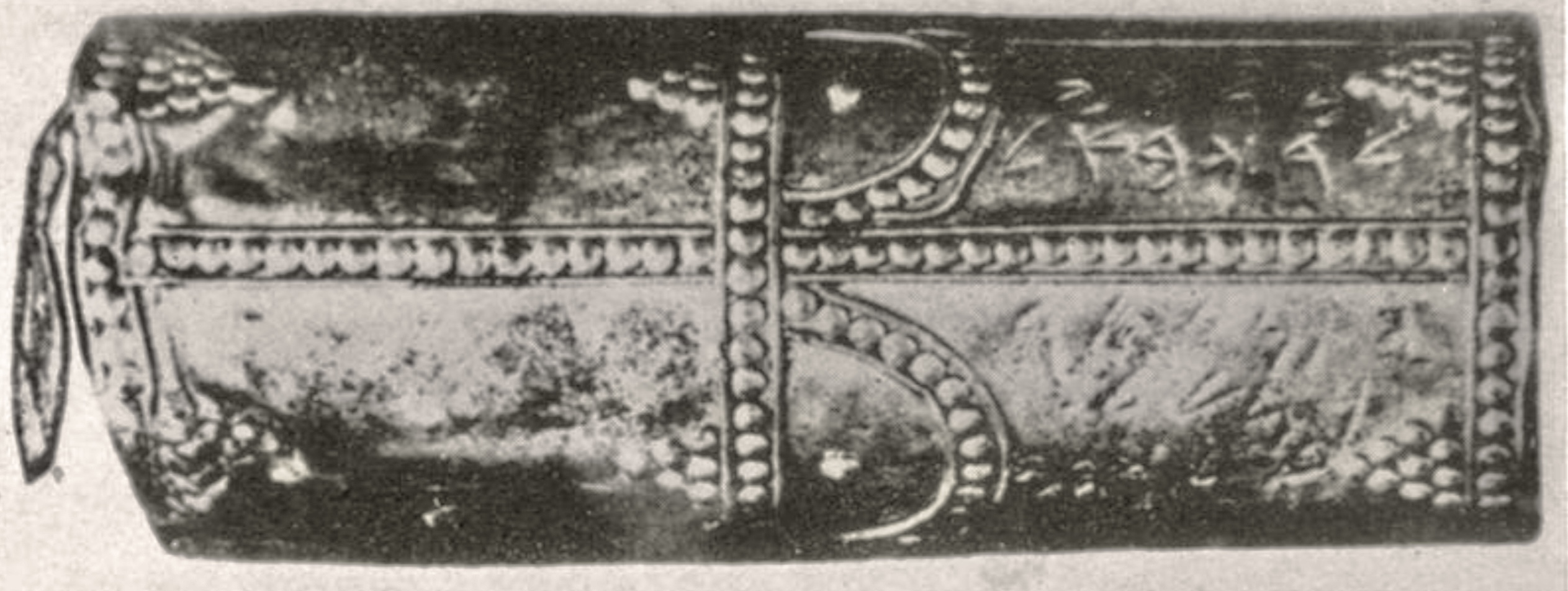|
Kilamuwa Scepter
The Kilamuwa scepter or Kilamuwa sheath is an 9th-century BCE small gold object inscribed in Phoenician or Aramaic, which was found during the excavations of Zincirli in 1943. It was found in burned debris in a corridor at the front of the "Building of Kilamuwa". King Kilamuwa is believed to have ruled in the area of Zincirli in ca. 830 - 820 BC. The object measures 6.7 x 2.2 cm, and is ornamented with soldered gold wire and gold plates; two of the rectangular plates are inscribed with a total of seven lines or writing. Felix von Luschan Felix Ritter von Luschan (11 August 1854 – 7 February 1924) was an Austrian doctor, anthropologist, explorer, archaeologist and ethnographer. Life Luschan was born the son of a lawyer in Hollabrunn, Lower Austria, and attended the Akademisches ... concluded that it was once on the handle (or sheath) of a staff or scepter. Text The text as presented by Dupont-Sommer is as follows. The text may be read as follows.Galling, Kurt. âThe ... [...More Info...] [...Related Items...] OR: [Wikipedia] [Google] [Baidu] |
Felix Von Luschan
Felix Ritter von Luschan (11 August 1854 – 7 February 1924) was an Austrian doctor, anthropologist, explorer, archaeologist and ethnographer. Life Luschan was born the son of a lawyer in Hollabrunn, Lower Austria, and attended the Akademisches Gymnasium in Vienna. After leaving school he studied medicine at the University of Vienna and anthropology in Paris, with an emphasis on craniometry. After he gained his doctorate in 1878, he was an army doctor in Austro-Hungarian occupied Bosnia and, together with the British archaeologist Arthur Evans, travelled through Dalmatia, Montenegro and Albania Albania ( ; sq, Shqipëri or ), or , also or . officially the Republic of Albania ( sq, Republika e Shqipërisë), is a country in Southeastern Europe. It is located on the Adriatic and Ionian Seas within the Mediterranean Sea and shares .... From 1880 he worked as a medical assistant at the Vienna General Hospital and a lecturer (''Privatdozent'') at the University of Vienna ... [...More Info...] [...Related Items...] OR: [Wikipedia] [Google] [Baidu] |
Phoenician Inscriptions
The Canaanite and Aramaic inscriptions, also known as Northwest Semitic inscriptions, are the primary extra-Biblical source for understanding of the society and history of the ancient Phoenicians, Ancient Hebrews, Hebrews and Arameans. Semitic inscriptions may occur on stone slabs, pottery ostraca, ornaments, and range from simple names to full texts. The older inscriptions form a Canaanite languages, Canaanite–Aramaic dialect continuum, exemplified by writings which scholars have struggled to fit into either category, such as the Stele of Zakkur and the Deir Alla Inscription. The Northwest Semitic languages are a language group that contains the Aramaic, Aramaic language, as well as the Canaanite languages including Phoenician language, Phoenician and Hebrew language, Hebrew. Languages The old Aramaic period (850 to 612 BC) saw the production and dispersal of inscriptions due to the rise of the Arameans as a major force in Ancient Near East. Their language was adopted as an ... [...More Info...] [...Related Items...] OR: [Wikipedia] [Google] [Baidu] |


